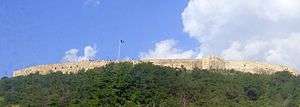Prizren Fortress
| Prizren Fortress | |
|---|---|
| Prizren, Kosovo[a] | |
 | |
| Site information | |
| Controlled by |
|
| Open to the public | yes |
| Site history | |
| Built | 11th century |
Prizren Fortress (Serbian: Призренски град/Prizrenski grad), also known as Kaljaja (Albanian: Каlаја, Serbian Cyrillic: Каљаја) and Dušan's Fortress (Душанов град/Dušanov grad), is a medieval fortress in Prizren, Kosovo,[a] which once served as the capital of the Serbian Empire. It was built on a hill above Prizrenska Bistrica, around which the modern city developed. The first fort, erected on this location by the Byzantines, was further expanded by Emperor Stefan Dušan (r. 1331–55). The fort then came under the control of the Ottomans for four centuries. It was declared a Monument of Culture of Exceptional Importance in 1948.[1]
History
Prizren was developed in the 11th century on the ruins of ancient Theranda, and it was first mentioned in 1019 at the time of Basil II (r. 976–1025) in the form of Prizdrijana. In 1072, Serbian ruler Constantine Bodin (r. 1081–1101) was declared "Emperor of the Bulgarians" in Prizren during the large Slavic uprising against the Byzantine Empire.
From the time of Stefan the First-Crowned (r. 1196–1228) and onwards, Prizren's importance increased, particularly during the reigns of King Stefan Milutin (r. 1282–1321) and Emperors Stefan Dušan (r. 1331–55) and Uroš V (r. 1355–71). The Prizren square and its stronghold developed the Via de Zenta trade route which passed through the Drin valley and connected the Adriatic Sea with the interior of the Balkan Peninsula. Dušan expanded the fortification and had his endowment, the Monastery of the Holy Archangels, built in its vicinity by the Višegrad fortress. Prizren served as the Serbian imperial capital for which it is called the Serbian Constantinople.


Right: The remains of one of the towers
During the fall of the Serbian Empire, up until the turn of the 14th century, the city was in the possession of several Serbian noble families, such as the Mrnjavčević family, the Balšić family, and the Branković family. With Ottoman expansion, it began to lose its commercial importance, so in 1433 it is mentioned as a deserted square. Prizren fell to the Ottomans on 21 June 1455, although some sources place it in 1459. The Ottomans expanded the fortress, and held it up until Prizren's capture by Serbia during the First Balkan War (1912).
During the Ottoman occupation of the Serbian lands, the Serbs held social gatherings at several monumental places, such as Kaljaja, where they danced the Kolo in the evening.[2]
See also
References
- ↑ Monuments of Culture in Serbia: ПРИЗРЕНСКА ТВРЂАВА, ДУШАНОВ ГРАД-КАЉАЈА (SANU) (Serbian) (English)
- ↑ Serbian Folk Dance Tradition in Prizren Ethnomusicology, Vol. 6, No. 2 (May, 1962)
Sources
- Deroko, Aleksandar (1950). Srednjevekovni gradovi u Srbiji. Prosveta.
- Zdravković, Ivan M. (1970). Srednjovekovni gradovi i dvorci na Kosovu u Srbiji. Turistička štampa.
Annotations
| a. | ^ Kosovo is the subject of a territorial dispute between the Republic of Kosovo and the Republic of Serbia. The Republic of Kosovo unilaterally declared independence on 17 February 2008, but Serbia continues to claim it as part of its own sovereign territory. The two governments began to normalise relations in 2013, as part of the Brussels Agreement. Kosovo has received recognition as an independent state from 110 out of 193 United Nations member states. |
External links
| Wikimedia Commons has media related to Kaljaja. |
Coordinates: 42°12′34″N 20°44′44″E / 42.20944°N 20.74556°E


